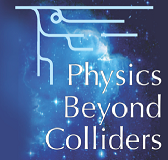Speaker
Description
The anomalous magnetic moment g-2 of the muon is a precision measurement which exhibits a 3.5$\sigma$ deviation between theory and experiment, and in the next few years will be measured at Fermilab and J-PARC with even higher precision.
The hadronic contribution to the muon g-2 ($a^{\rm HLO}_{\mu}$) is the most important one after the pure QED contribution. It is however affected by a large uncertainty which
dominates the error on the theoretical prediction in the Standard Model.
Considering the present observed deviation of the experimental measurement, it
is extremely important to get an independent measurement of the hadronic
contribution to g-2 to reduce its uncertainty.
We propose a novel approach to determine the leading hadronic corrections to the
muon g-2.
It consists in a measurement of the effective electromagnetic coupling in the
space-like region at low-momentum transfer.
We discuss the possibility to perform this measurement by taking advantage of
the high energy muon beam in the CERN North Area.
We plan to realize a fixed target scattering experiment aiming at achieving a
per mille accuracy on $a^{\rm HLO}_{\mu}$. Such an accuracy will allow an
alternative determination of this fundamental quantity competitive with the
present results obtained with the dispersive approach via time-like data.
Such precision would therefore allow a more stringent test of the Standard Model
when compared with the g-2 measurements expected at Fermilab and J-PARC.
